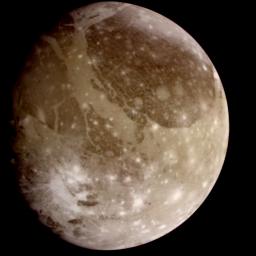
The same team of scientists had previously found a tenuous veil of oxygen around another Jupiter moon, Europa.
The observations also suggest that Ganymede, like Earth and Jupiter itself, has polar aurorae -- light displays created when charged particles collide with atmospheric gases.
The findings will be presented as a poster paper on display throughout a meeting of the American Astronomical Society's Division of Planetary Sciences, from Oct. 23 to Oct. 26 at the Tucson Convention Center in Tucson, Arizona.
A team of astronomers used the Hubble telescope's Goddard High Resolution Spectrograph on June 21 to make ultraviolet observations of Ganymede. The astronomers were excited when they saw the spectrum had the characteristic fingerprint that indicates the presence of oxygen gas. But they were puzzled because the spectrograph had detected two peaks, where the astronomers were expecting to see at most a single spike. They soon realized, however, that the two spikes could be explained by the existence of light emitted from two regions near Ganymede's north and south poles.
"The bright spikes correspond nicely to the poles of Ganymede," said Doyle Hall, the Johns Hopkins University astronomer who led the team making the oxygen discovery. Hall called the data "very tentative evidence for the existence of polar aurorae."
Ganymede and Europa are both at least partially covered with water ice. The scientists believe that the atmospheric oxygen comes from the icy surfaces, where oxygen atoms are split off from water molecules that are bombarded by charged particles; exposure to sunlight and meteor impacts also could create some of the gas, Hall said.
The atmosphere on Ganymede is likely to be as thin as the gas previously detected on Europa, comparable in pressure to Earth's atmosphere at an altitude of several hundred kilometers, roughly as high as the space shuttle orbits.
"I want to emphasize that all of the results that we have seen related to oxygen do not require nor imply the presence of life," Hall said. This is in contrast to the oxygen in Earth's atmosphere, which is generated by biological activity. "In fact, the surfaces of these moons, as far as we can tell, are completely inhospitable to any life form that we can imagine."
The other members of the research team were Paul Feldman, a professor in the Johns Hopkins Department of Physics and Astronomy; Darrell Strobel, a professor in the Department of Earth and Planetary Sciences; and astronomer Melissa McGrath from the Space Telescope Science Institute in Baltimore -- the same scientists who used the Hubble telescope to detect an oxygen atmosphere on Europa about two years ago.
Polar aurorae are created when charged particles are guided by a planet's magnetic field toward its poles. As the charged particles collide with atmospheric gases they create brilliant and colorful emissions, which on Earth are known as the Northern and Southern lights. Earth, Jupiter, Saturn, Uranus and Neptune are known to have polar aurorae.
If confirmed, the Ganymede findings "would be the first detection of polar aurorae on any planetary satellite," Hall said.
The astronomers observed ultraviolet light from Ganymede because in the visible spectrum the faint oxygen emissions would have been overwhelmed by bright sunlight reflecting off the moon's surface.
Scientists believe there are three prerequisites for the existence of polar aurorae on a planet or satellite: an atmosphere, a magnetic field, and a population of charged particles. At nearly the same time that the astronomers were using the Hubble telescope to detect the atmospheric oxygen, scientists operating NASA's Galileo spacecraft discovered both a magnetic field and charged particles around Ganymede.
The research is being funded by a two-year grant from the Space Telescope Science Institute totaling $76,000.